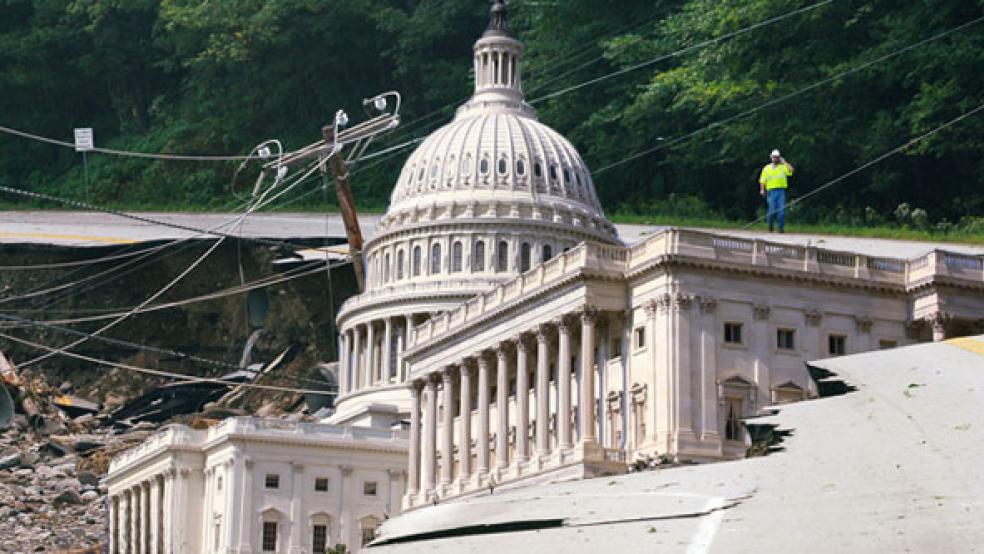The Senate on Monday evening passed a bipartisan deal with the House to avert a government shutdown and assure that federal disaster relief funds continue to flow, after angering many of the hundreds of thousands of Americans left homeless or in bad shape by hurricanes and floods. [For a run-down of where Americans are still suffering, see below.]
The turning point came earlier Monday when the White House Budget Office confirmed that the Federal Emergency Management Agency (FEMA) had about $114 million in disaster aid funds remaining in its coffers, enough to get through the week before the start of a new fiscal year on Saturday.
The Republicans who control the House and Democrats who control the Senate have been bickering for weeks over whether $1 billion of additional emergency FEMA spending this year should be offset with cuts in other areas, as the GOP has insisted.
But with the news that FEMA had enough to get along until the start of the new fiscal year on Saturday, the controversy vanished and the Senate and House leaders figured out a series of parliamentary maneuvers to keep the government fully operational at least through Nov. 18. Under the deal approved by the Senate, 79 to 12, FEMA will be able to begin drawing down $2.65 billion when the new fiscal year begins.
“Let’s fight when there is something to fight about,” said Senate Majority Leader Harry Reid, D-Nevada. “There is nothing to fight about tonight.”
“This is a reasonable compromise,” Senate Minority Leader Mitch McConnell, R-Kentucky, said on the Senate floor. “This fire drill has been completely unnecessary.”
The Senate action, which will be followed later this week by unanimous consent of the House even though most members will be back in their districts for a recess, marks the third time in nine months that Congress has skirted with a government shutdown or default on the U.S. debt – generating widespread uncertainty and bitterness on the part of average Americans and state and local officials.
Vermont Gov. Peter Shulmin, a Democrat, summed up that frustration earlier in the day, before the House-Senate deal was announced. “We cannot find words to express our disappointment with a lack of action from Congress in our time of need,” Shulmin told The Fiscal Times. “It seems like they will spend hundreds of millions in Iraq, and then when we have hard-working, taxpaying Americans knocked on their knees, suddenly we need to justify our need for relief. I don’t get it.”
In effect, congressional Republicans and Democrats were feuding over the equivalent of 0.4 percent of the overall federal budget, which is indicative of the huge gulf separating the two parties over spending and fiscal matters.
On Friday the Senate rejected the House version of a short-term funding measure that included $3.65 billion for FEMA, with $1 billion available immediately for the remainder of the fiscal year, which ends on Sept. 30. House Republicans insisted that the $1 billion for victims of floods, hurricanes and tornadoes should be offset with cuts to a program for development of vehicles using alternative fuels.
“This hasn’t happened before,” said a Democratic Senate aide. “There has never been an issue over whether we should fund FEMA or not. It is unprecedented Congress would consider holding up disaster assistance to those who need it.”
Some Republicans, including Rep. Ron Paul, R-Tex., a presidential contender, said FEMA should be eliminated all together. “The establishment of FEMA is symptomatic of a blind belief in big government's ability to do anything and everything for anyone and everyone,” Paul said in a statement. “True compassion would be to get FEMA out of the way.”
Political posturing over government spending has paralyzed Congress’s ability to accomplish much of anything this year, and failure to approve a continuing resolution to keep the government operating beyond the Sept. 30 deadline would have been another hit to the government’s credibility, which already suffered a credit downgrade following the debt ceiling debacle this summer.
While it will take months to determine an accurate total estimate of the damage from Hurricane Irene, there is no question it will rank as the 10 billion-dollar weather event of the year, breaking the record dating back to 1980, according to National Climatic Data Center. Many industry experts have put the cost of the storm at $7 billion to $10 billion, in part because Irene scarred such a large portion of the Atlantic seaboard. Meanwhile, victims in some states are still homeless and trying to get back to work. States are struggling to rebuild from the hurricane and other natural disasters.
North Dakota
North Dakotan have been repeatedly pounded by floods that left Bismarck and Minot, the state’s largest cities, water-logged and struggling to recover before another harsh winter sets in. When Hurricane Irene slammed the East Coast, it diverted disaster-relief efforts and funding from the upper Midwest.
More than $336.7 million in federal and state disaster assistance has been provided to North Dakotans for this year`s spring flooding, but much more is needed. Roughly 11,000 people were evacuated from Minot and 4,000 homes were flooded, according to officials. Nearly two months after floodwaters largely receded, Minot still is waiting to bring many of its flooded mobile home parks back on line. The total damage to Minot public school buildings alone is estimated at about $50 million.
In Bismarck, the Missouri River dropped more than two feet this week, but flood cleanup and rebuilding has been moving at a snail’s pace. "A lot of us are gutted, and it takes a really long time to dry out," Stacy Sturm, who lives in Sibley Island Estates south of Bismarck, told the Bismarck Tribune.
Throughout the state, flooding and last winter’s blizzards have left roads and bridges washed out and virtually impassable for motorists. The state is waiting for at least $13.3 million for 97 projects to elevate or repave roads, according to a FEMA spreadsheet.
Vermont
Hurricane Irene dumped so much rain on the Green Mountain State that it flooded more than 200 roads, some 100 historic covered bridges, and nearly 10 percent of the population lost electricity for several days. Gov. Shulmin said he wouldn’t be surprised if damage costs exceed $1 billion. While crews are still working to repair roads in the aftermath of the storm, about 95 percent of the state’s roads are now open.
The Vermont Rail System experienced 98 washouts, approximately 11 miles of rail track. “We’ve been operating the railroad since 1964 and we’ve not seen anything like this,” said David Wulfson, President of the Vermont Rail System. “This thing was so widespread and it came so quick. It’s the type of stuff you see on TV.” The railroad has done approximately $14 million in repairs.
Shulmin said that unlike states in the South that were hit by the hurricane, Vermont is racing against winter to finish repairs. “Time is not on our side,” he said. After the second week in November, crews won’t be able to spread pavement as most of the state begins to experience a deep freeze. “Every day that Congress is down there bickering about offsets, we are losing time to get Vermonters into warm houses and passable roads and bridges,” Shulmin said.
North Carolina
Hurricane Irene first made landfall Aug. 27 on the Outer Banks of North Carolina and then tore its way up the East Coast. It’s estimated that 1.3 million residents were affected by the storm and more than 26,000 have applied for federal assistance. Agriculture was hit especially hard, with crop damage expected to exceed $400 million, Democratic Sen. Kay Hagan said. So far FEMA has doled out $18 million in disaster relief funds for housing and other needs, not including public assistance programs.
“While FEMA, USDA, and other federal partners are working hard to provide assistance to North Carolina communities ravaged by Hurricane Irene, storm victims still have urgent needs,” Julia Hagan, spokesperson for North Carolina’s emergency management agency, said in a statement. “Some families, with no other options, have been living in tents. Congress must put ideology aside and appropriate necessary disaster relief funding NOW.”
Pennsylvania
Pennsylvanians were barely recovering from Hurricane Irene when they were clobbered again by Tropical Storm Lee, overflowing the Susquehanna and its tributaries,and forcing the evacuation of more than 100,000 people. “Members of Congress are playing with people’s lives, not just their own political careers,” Martin J. Bonifanti, chief of the Lake Winola volunteer fire company, told The New York Times: “While they are rattling on among themselves down there in Washington, people are suffering.”





